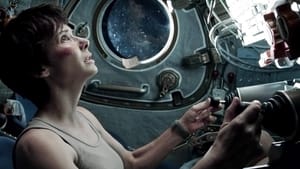Stay in the Loop
BSR publishes on a weekly schedule, with an email newsletter every Wednesday and Thursday morning. There’s no paywall, and subscribing is always free.
Exploring outer space?
First, check your brains at the door
Alfonso Cuarón’s 'Gravity' (1st review)

When I wrote about the space adventure film Europa Report this past August, I complained that nearly all movies in outer space movies fail because, no matter how exciting and full of special effects they may be, they fail to answer or resolve the problem of space as a visual image system or filmic concept. (Click here.)
One problem is that the plot, action, characters or computer graphics in these films become so dominant that the very notion of space exploration and the possibilities of life on other planets leads to a predictable showdown involving human heroics versus the breakdown of technology, the mystery of the unknown or the presence of alien forces of evil.
Hollywood conventions, in a word, undermine any hope for gravity in these films.
Cold, beautiful horror
Maybe I’m asking too much of the movies. It’s not that I want a “Nova” special on the physics of supernovas and the colors of the rings of Saturn. Nor do I want a NASA website that monitors the flickering light shows of a far-flung universe from now until eternity.
But if a film is to take as its primary setting the slow swirling vortexes of prismatically colored stars in the vast dark blue wash of the depths of space, something needs to be stated or implied about the meaning that humans derive from their access to the visible but inexplicable nothingness that is the infinity of the universe.
In director Alfonso Cuarón’s widely praised new movie, Gravity, outer space is mostly given its due as a boundless, colorful, forbidding zone of cold, beautiful, inhospitable horror. The characterization of space itself as a dangerous place is achieved through the vividly composed computer graphics sequences and cinematography (by Emmanuel Lubezki).
Here come the Russians
Visually, the film renders the mise en scène and actors– there are only two, George Clooney and Sandra Bullock— in a constant, topsy-turvy, chaotically dense realm of flying, spinning, suspended hurricane-like torrents of debris. If you see Gravity in its 3-D version, you might find yourself, as I did, ducking when a shard of a demolished space station heads toward your eyeball.
Plotwise, Gravity is simple. The film opens outside of a Shuttle Explorer, where a grizzled astronaut, Matt Kowalski (George Clooney), and first-time space flyer, engineer Dr. Ryan Stone (Sandra Bullock), are busy repairing a disabled section on a wing. Actually, Dr. Stone and another astronaut are doing all the work while Kowalski tools around on a self-propelled spacesuit with the intent, he admits, of breaking the record of time spent in space held by a Russian cosmonaut.
But they’re unable to complete the routine maintenance because they learn, from Houston, that the Russians have destroyed a satellite nearby (who knew that outer space has neighborhoods so close!) and a whole junkyard of fragmented pieces is heading their way.
Against all odds
Within a minute, the Shuttle Explorer is mangled and the third astronaut is tossed, like a pebble falling in an ocean, into deep space. Kowalski and Ryan are blown into the darkness. With all the rush that a movie can muster— sonically, visually, viscerally— the idea of how empty the universe really is overwhelms the audience. For the rest of the film, Ryan must overcome the odds and find a way to return to earth.
Unfortunately, at this point— when the human psychological, emotional, existential drama begins— Gravity becomes just another movie.
It’s very tightly written and well scored, to be sure, and Sandra Bullock gives a convincing performance. Her struggle with her situation, her physical feats— including smashing into an orbiting space platform and floating through a refuse-strewn quarters in an abandoned station— are at once acrobatic and painful. The audience has no choice but to identify with her and cheer when she figures out how to save herself. It’s all heroic and thrilling.
Unanswered questions
But as for space exploration, Alfonso Cuarón and his co-writer— his son, Jonás— barely hint at how the mess Kowalski and Ryan get into is caused by the human-made flotsam from the Russian act of blowing up a satellite. Nor, since Gravity ends as expected (does Sandra Bullock ever get killed in a movie?), do the writers explore the psychological effects of Ryan’s ordeal on herself.
Nor do they suggest anything thoughtful about the universe, the uses and consequences of science and advanced technology or the raison d’être for exploring space. At best, the last scene indirectly conveys a sense of doubt about the purpose or meaning of what astronaut Stone has been through.
My alternate ending
So, go see Gravity for its sheer excitement, spectacular effects and uplifting finish. But here’s my suggestion for an alternative ending:
It’s six years later and a grim, taut, angry Dr. Ryan Stone is on the run for her life. We learn that although she was treated like a hero, she was traumatized by her experience in space. Inadvertently, her celebrity status allowed her to gain access to sources and records involving space programs worldwide. She started asking questions and uncovered documents and conspiracies among all nations and hundreds of companies.
Space, she concludes, is an economic and militaristic domain, propped up by phony political posturing and duped “scientists” and their research support systems. The “space scam,” as she calls it, is a self-serving financial scheme that’s also twisting international politics and harms progress on human life by diverting money and resources. (This may be more than Sandra Bullock can handle.)
Following Edward Snowden and Julian Assange, Dr. Stone publishes all of her classified materials and even enlists a renegade filmmaker (George Clooney). They actually meet as Ryan is being taken care of by an underground network of open-source activists.
In a brief montage, we see images of Ryan with Steven Hawking, the Dalai Lama and Richard Dyson. We read her notes on a book that she is planning. It begins, “Life on earth must be grasped first. The cosmos is a poetics to be explored by human imagination. It offers a cipher for understanding the differences and singularity that constitute of unity of people and life…”
To read another review by Alaina Mabaso, click here.
What, When, Where
Gravity. A film directed by Alfonso Cuarón. For Philadelphia area show times, click here.
Sign up for our newsletter
All of the week's new articles, all in one place. Sign up for the free weekly BSR newsletters, and don't miss a conversation.

 AJ Sabatini
AJ Sabatini